Why is the Bering Sea Important?
Dr. Vera Alexander
Dean, School of Fisheries and Ocean Sciences
Professor of Marine Science
University of Alaska Fairbanks
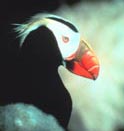 |
| Tufted Puffin |
The Bering Sea is one of several biologically productive subarctic seas. The Bering, Barents, Greenland, Norwegian and Okhotsk seas each support lucrative fisheries. All are transitional regions, influenced by both the Arctic and either the North Pacific or Atlantic Oceans respectively, and to a greater or lesser extent they share some properties with the arctic waters to the north. It is interesting to note that the rich biological populations are influenced and to some extent result from this juxtaposition. In discussing the biological regimes of the Bering Sea, the words often used are "teaming", "richest", "most productive", and so on. Indeed, there is evidence that the Bering Sea is extraordinarily productive, especially at the so-called higher trophic levels---that is, it supports large populations of birds, mammals and fish.
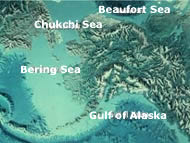 |
| The Bering Sea |
The topography of the Bering Sea comprises a deep ocean basin to the south and west, and a huge continental shelf to the north and east; this shelf continues through the Bering Strait into the Chukchi Sea to the north. Water from the North Pacific Ocean, rich in plant nutrients, flows northward over the shallow continental shelf, through the Bering Strait, and over the Chukchi Sea Shelf into the Arctic Ocean.
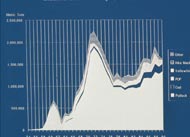 |
| Groundfish catch, 1954-1990 |
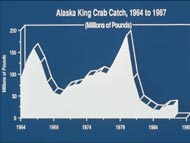 |
| Alaska King Crab Catch, 1964-1987 |
The earliest explorers in the region were impressed with its biological wealth and, not surprisingly, since those early days human beings have continuously harvested the bounty. Native residents had developed cultures based on marine resources, and today, coastal communities in Western Alaska still rely on the adjacent waters for economic or subsistence use. Commercial exploitation has been intense over the years. To be sure, the dominant species varied; it included Pacific cod (Gadus macrocephala), sea otters (Enhydra lutis), fur seals (Callorhinus ursinus), whales, crabs, salmon and, most recently, pollock (Theragra chalcogramma). (Although not addressed in this essay, walrus and beluga whales are important subsistence species in the northern Bering Sea.) Today, the Bering Sea pollock fishery is the largest single species fishery in the world, providing a substantial proportion of the annual fish catch of the United States. Yet, pollock also is a major component of the marine food web. Herein lies the importance of research in the Bering Sea. Whether the huge harvest of fur seals and sea otters in the 1800s, or the extensive whaling in the1900s, large harvests have persisted. Yet, our knowledge of the region remains inadequate for understanding the ecological impact of removing large numbers of a single species. It is always popular among scientists to say "more studies are needed." but in this case the statement is unequivocally true. The decline in numbers of some mammals and birds in the Bering Sea has not been easy to explain, and much less easy to influence (for more information, see NRC, 2002). Cascading effects over the long term might explain some of the changes (see NRC, 1996), but only against the background of ecosystem response to the spectacularly variable oceanic and atmospheric conditions in this region. Measures taken to address the declines have necessarily been restrictive on the fishing industry, given the uncertainty about the causes. Fortunately, much work has been done, but the complexity and remoteness of the Bering Sea, the variability of the conditions there, as well as the historical lack of information all demand a sustained major research commitment along with long-term operational observations.
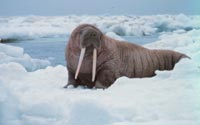 |
| Walrus on the ice in the Bering Sea |
In common with the Chukchi Sea, the Bering Sea is covered with sea ice in the winter to a greater or less extent, depending on the year. There are few natural events in the world oceans more dramatic than the annual advance and retreat of the seasonal sea ice over the Bering Sea shelf. The annual sea ice advance can be as great as 900 kilometers, with huge oceanographic and biological consequences. This ice serves as a platform in winter for marine mammals such as ice seals and walrus, and also as the habitat for extensive plant growth in the spring. The spectacular phytoplankton bloom, which follows the retreating ice edge, is a major event in April or May (Alexander and Niebauer, 1981; Hunt and Stabeno, 2002). Inter-annual variations in the ice and consequently the bloom have a large impact on the ecosystem of the Bering Sea shelf.
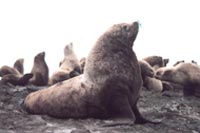 |
| Steller Sea Lions, whose numbers have declined in recent years |
The biological regime of the Bering Sea has changed over the years. A dramatic change in the modern era was the abrupt decline of the king crab population, and the rise of the pollock fishery. The decline may have been due to over-fishing in part, or perhaps to climatic and environmental change. Since that time, we have been faced with declines of some species of mammals---fur seals, Steller sea lions and, recently sea otters. We have learned that there are dramatic changes in physical conditions, driven by atmospheric processes, which result in major biological changes. A clear example was a "regime shift" in 1976-1977. This shift resulted in a major decrease in the annual extent of sea ice, a significant warming of the Bering Sea, highly variable conditions in spring and variability in the spring phytoplankton bloom. A strong El Nino followed in the late 1990s, with even more dramatic warming; there was a massive die-off of seabirds and the appearance of an exotic bloom of a Coccolithophorid phytoplankton species rarely found in the Bering Sea. For an examination of some of the current thinking on these events, see Hunt and Stabeno (2002).
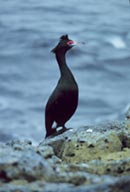 |
| Cormorant in the Pribilof Islands in the Bering Sea |
We now recognize that the climatic/oceanographic/biological interactions in this region are extremely complex, and that many factors play a role in determining ecological outcomes. We have to support long-term carefully designed research if we are to maintain the integrity of the Bering Sea while continuing to benefit from its harvests. Fortunately we have amassed a large amount of information through studies starting in the 1970s and continuing today. Multiple agencies have supported this research, and scientists from academia and federal agencies, often working with international partners (Japanese and Russian scientists) have cooperated in many of the programs. Nevertheless, a systematic well-planned suite of long term observations as a backdrop to focused ecological and oceanographic studies is needed. This will provide the knowledge needed to manage our activities taking the entire ecosystem into account. Addressing the effects of man-induced of changes through harvesting and contamination against the background on natural cycles and interannual and long-term environmental change demands a sophisticated understanding. Herein lies the "grand challenge" in our attempt to maintain the integrity of the Bering Sea ecosystem.
References:
Alexander, V. and H. J. Niebauer. 1981. Oceanography at the eastern Bering Sea ice edge zone in spring. Limnology and Oceanography 26:1111-1125.
Hunt, G. L. and P. J. Stabeno. 2002. Climate change and the control of energy flow in the southeastern Bering Sea. Progress in Oceanography 55:5-22.
National Research Council. 1996. The Bering Sea Ecosystem. National Academy Press, Washington, D.C.
National Research Council. 2003. Decline of the Steller Sea Lion in Alaskan Waters. National Academy Press, Washington, D.C. 204 pp.
Additional Information:
- Gallery of Seal and Sea Lion photographs from National Marine Mammal Laboratory
- Gallery of Whale, porpoise, and dolphin photographs from National Marine Mammal Laboratory
- About Marine Mammals - from the National Marine Mammals Laboratory
- Plants and Animals from the Bering Land Bridge National Preserve
